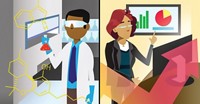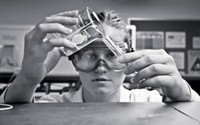Advertisement
Grab your lab coat. Let's get started
Welcome!
Welcome!
Create an account below to get 6 C&EN articles per month, receive newsletters and more - all free.
It seems this is your first time logging in online. Please enter the following information to continue.
As an ACS member you automatically get access to this site. All we need is few more details to create your reading experience.
Not you? Sign in with a different account.
Not you? Sign in with a different account.
ERROR 1
ERROR 1
ERROR 2
ERROR 2
ERROR 2
ERROR 2
ERROR 2
Password and Confirm password must match.
If you have an ACS member number, please enter it here so we can link this account to your membership. (optional)
ERROR 2
ACS values your privacy. By submitting your information, you are gaining access to C&EN and subscribing to our weekly newsletter. We use the information you provide to make your reading experience better, and we will never sell your data to third party members.
Business
Brewing up an analytical services firm
A surge in craft beers gives rise to a niche market for analytical chemistry
by Craig Bettenhausen
March 21, 2016
| A version of this story appeared in
Volume 94, Issue 12

Beer selection in the U.S. has never been better. In 2016, the number of craft breweries dotting the landscape will surpass the record of 4,131, set in 1873. Small-scale production of hard cider, mead, liquor, and kombucha is also on the rise, and home-brewing all kinds of fermented beverages is a growing hobby.
This explosion of diversity has created a niche market for brewing analytical services: chemists and biologists who help brewers figure out exactly what’s in their tanks—and how to make it taste better.
“The analytical service market is still young because the craft brewing industry is still young,” says consultant Marty Ochs of E3 Craft Strategies. In 2006, the Brewers Association, an industry group, counted only 1,500 craft brewers, which it defines as breweries and brewpubs putting out less than 6 million barrels per year.
But with more than 4,000 brands on the market today, “services, from every angle, have not caught up,” Ochs says. The vendors that have been around a long time aren’t geared toward the small craft brewer, he says, and have a pricing structure and business model focused on bigger, scaled-up companies.
Major labels such as Budweiser have always had staff scientists doing quality assurance and control (QA/QC), but in-house labs at small to medium-sized operations are becoming more and more common.
Dana Garves established and ran the QA/QC lab at Oregon’s Ninkasi Brewing Co. Four years into the job, she opened the lab to home-brews made by Ninkasi staffers. “Pretty soon, people were bringing favors for other companies,” she says. In 2014, she struck out on her own to form BrewLab, an independent brewing analytical services provider.
“The one that really struck home for me was when a small brewpub in Michigan sent a growler of beer to me via their mother’s brother’s best friend’s cousin,” Garves recounts. She got a small business loan from a local bank with experience in the brewing industry and converted her garage into a laboratory.
Garves’s workhorse instrument is an Alcolyzer from Anton Paar. The Alcolyzer uses a combination of sonic and spectroscopic methods to measure “brew stats” such as alcohol by volume (ABV), calories, density, and degree of fermentation.
She uses a standard ultraviolet-visible spectrometer to measure bitterness in beer, which comes from isomerized α-acids—bitter, flavorful, aromatic compounds derived from hops—and is measured in international bitterness units (IBU). The α-acids have characteristic spectroscopic features in the UV range. In addition to IBU, the UV-Vis is used to quantify color.
Home-brewers and many small operations estimate IBU based on the amount of hops they use and gauge ABV using handheld density or optical refraction instruments. Those formulas and tools work at the hobby level, but they don’t scale up well. Good data allow a brewer to adjust recipes with less guesswork. BrewLab packages ABV, IBU, and pH for $35, among other services, and can turn results around in 48 hours.
A year in, business is good, Garves says, “and it’s always growing.” Word of mouth has helped. “It’s one of the things that’s really awesome about this industry,” she says. “There is competition, but more often than not it’s collaboration.”
Only about one-fifth of her 60 clients are home-brewers, which has been a surprise. The majority are craft breweries and brewpubs. “I initially wanted to focus primarily on home-brewers; there’s not a lot of resources out there for them. But they’re slowly trickling in.” She also has a lot of cider clients, one mead maker, and two making kombucha, a cultured probiotic drink made from sweet tea.

BrewLab is one of a handful of small shops with business models designed to serve small start-up brewing operations. Some craft brewers with in-house labs, such as Widmer Brothers Brewing, also offer contract analytical work. Established third-party labs are starting to respond as well.
Kara Taylor is the analytical lab manager at White Labs, a major provider of yeasts, enzymes, and chemicals to everyone from home-brewers to the majors. Her six-person lab offers an array of analytical services including pH and genetic analysis.
As Taylor sees it, there are two major players in the brewing analytical services market: White and Brewing & Distilling Analytical Services (BDAS), which has four staff members. For the most part, Taylor says, the market is divided among White, BDAS, and in-house labs.
In addition to analytical services, White also consults with breweries looking to build their own labs. The in-house versus outsource decision comes down to what the brewery is willing to invest, Taylor says. Also, “third-party labs are attractive to some people because we see a variety of everything that’s happening across the industry.”
The expertise needed is a combination of microbiology and chemistry. “Almost everything we do is pretty basic wet chemistry,” she says. “You also need expertise in food science: how proteins, acids, and alcohols work together,” as well as some biology.
Both White and BDAS have added staff and retooled their business models in recent years in response to the rapid growth of the craft beer industry. “An increased emphasis on quality has been important,” Taylor says. “People have been willing to spend a little bit more money on lab services to check the quality of their beers.”
A new U.S. regulation is set to give another boost to the brewing analytical services market. Starting in December, any restaurant chain with more than 20 locations must provide a complete nutrition facts label for each beer on its menu. That label costs around $635 to produce at White. “Without regulation, there’s not a lot of money in this type of analysis,” Taylor observes.
But regulatory compliance isn’t enough to make a brewery successful. Ochs, the consultant, tells his clients that good QA/QC is crucial to growing their business into a profitable venture with a full-time staff.
“Any brewery needs a brewer that understands what lab work they need to do. And if they don’t have a lab, they need Dana or somebody like Dana,” he says, referring to Garves of BrewLab. “Any brewery that doesn’t have a legitimate lab process set up, it’s a joke. They’re not a real brewery in my book.”





Join the conversation
Contact the reporter
Submit a Letter to the Editor for publication
Engage with us on Twitter